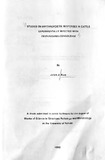| dc.description.abstract | Since the anaemia of T. congolense infection, which has been
shown to be mainly due to erythrocyte destruction by macrophages of
the mononuclear phagocytic system, has been shown to be associated
with poor reticulocyte response, a study was designed to verify if the
unresponsiveness is attributable to low erythropoietin levels. In the
absence of commercially available bovine erythropoietin, a
radioimmunoassay based on human urinary erythropoietin was assessed
in measuring bovine erythropoietin levels, but was found to be
unsuitable, presumably because the polyclonal antibody to human
erythropoietin could not recognise bovine erythropoietin.
An in vitro bioassay which indirectly measures erythropoietin levels
by utilising erythropoietin's stimulatory effect on 1251-deoxyuridine
(IUDR) incorporation in DNA of spleen cells from phenylhydrazine treated
mice was able to measure erythropoietin levels in bovine plasma. The
assay could detect minimum of 62.5 mU/ml of erythropoietin in plasma.
Using the in vitro bioassay, increased erythropoietin levels were detected
in calves as early as 6 hours post-bleeding (hpb) of 50% of their
estimated total blood volume. The peak levels of 1225 mU/ml was
reached at 33hpb and dropped below the detection limit of the assay by
72hpb. Reticulocytes appeared in the blood of the calves by 72hpb and
this was followed by a macrocytic hypochromic anaemia during the
recovery period.
From 18 day post-infection (dpi) onwards, undiluted plasma
collected from T. congolense infected animals suppressed IUDR
incorporation into spleen cells. Diluting the plasma five fold decreased its
suppressive effect and allowed the detection of erythropoietin.
(x)
Using diluted plasma in the assay, distinct erythropoietin peaks were
observed both in the acute stage of the disease when the packed cell
volume (PCV) was dropping rapidly and in the chronic stage when the
PCV had stabilised between 16-17%. Increased erythropoietic response
occurred throughout the acute stage of the disease indicated by
progressive increase in mean corpuscular volume. During the chronic
stage of the disease (39-76 dpi) the anaemia was macrocytic
hypochromic and there was very few reticulocytes (0.2-0.4%). From
76dpi, despite low PCV and peaks of elevated erythropoietin, the
erythropoietic response waned as indicated by a normocytic
normochromic anaemia and an absence of reticulocytes. This suggests
the bone marrow was unresponsive to elevated plasma erythropoietin.
Cattle treated in the chronic stage of T. congolense infections
recovered their normal PCV although their erythropoietin levels were
below the detection limit of the assay. The animal treated on 57dpi
recovered its pre-infection PCV four weeks after treatment while an
animal treated on 85dpi had only recovered 84% of its pre-infection PCV
11 weeks after treatment. | en |

